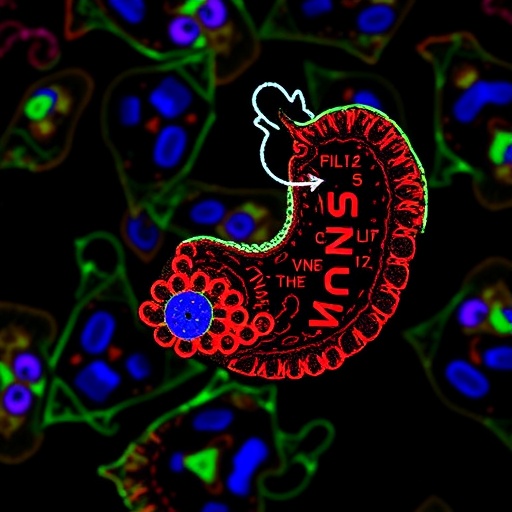In a groundbreaking study poised to reshape our understanding of pancreatic cancer progression, researchers have identified BNC2 as a pivotal molecular driver that orchestrates critical changes in tumor biology. This discovery, detailed comprehensively by Li, Yu, Yu, and colleagues in the journal Medical Oncology, shines a new light on the transcriptional regulation mechanisms fueling pancreatic cancer, one of the deadliest malignancies globally. The team’s findings illuminate how BNC2 influences the expression of key genes, notably COL3A1, and propels the epithelial-to-mesenchymal transition (EMT), a process intimately linked with cancer invasiveness and metastasis.
Pancreatic cancer remains notoriously difficult to treat owing to its aggressive nature and late diagnosis. At the heart of this malignancy’s lethal behavior lies a complex network of genetic and epigenetic factors that regulate tumor cell plasticity and dissemination. The identification of BNC2 as a novel oncogenic driver offers a new avenue for therapeutic intervention. By delving into the transcriptional landscape, the researchers demonstrated that BNC2 modulates a gene signature that fosters an environment conducive to cancer cell migration and invasion.
The study employed sophisticated molecular biology techniques, including chromatin immunoprecipitation sequencing (ChIP-seq) and RNA sequencing, to unravel the direct targets of BNC2. Among these targets, COL3A1, encoding type III collagen, surfaced as a critical mediator. Type III collagen, a component of the extracellular matrix (ECM), is known to influence tumor microenvironment dynamics, tissue remodeling, and metastatic potential. The elevation of COL3A1 expression under BNC2 control underscores a mechanistic link between transcription factor activity and ECM modulation in pancreatic cancer progression.
Integral to the process of metastasis is the epithelial-to-mesenchymal transition, whereby epithelial cancer cells acquire mesenchymal traits that confer migratory and invasive properties. The team’s data distinctly showed BNC2’s role in regulating EMT-related gene expression, thereby facilitating the transition and enabling tumor cells to detach and invade surrounding tissues. This regulatory effect positions BNC2 not just as a bystander, but as a master regulator orchestrating phenotypic plasticity in pancreatic cancer.
Further exploration of the molecular pathways revealed that BNC2 influences a network of EMT transcription factors, including pivotal players such as Snail and Twist. The coordinated upregulation of these factors in response to BNC2 activity substantiates a cascade model in which BNC2 drives a transcriptional program conducive to cancer cell dissemination. These insights pave the way for targeting BNC2 or its downstream effectors to disrupt EMT and metastasis.
Importantly, the research team validated their in vitro findings using in vivo pancreatic cancer models. Animal studies fortified the premise that BNC2 overexpression dramatically accelerates tumor growth and metastatic spread, correlating with increased COL3A1 levels and pronounced EMT features. This translational component of the study underscores the clinical relevance of the molecular insights gained and positions BNC2 as a potential biomarker for aggressive disease.
The clinical implications of these findings are profound. By uncovering BNC2’s centrality to pancreatic cancer progression, new therapeutic strategies that inhibit BNC2 function or its transcriptional network could emerge, potentially halting or reversing tumor spread. The feasibility of targeting transcription factors has historically been challenging, yet advances in drug development could soon overcome this barrier.
Furthermore, the elucidation of COL3A1 as a downstream effector engages the stromal compartment of the tumor, suggesting a dual approach that targets both cancer cells and their microenvironment might be efficacious. This approach aligns with contemporary paradigms in oncology recognizing the tumor microenvironment as an active participant in cancer progression.
The study’s findings also invite reevaluation of diagnostic and prognostic tools for pancreatic cancer. Elevated BNC2 and COL3A1 expression levels could serve as biomarkers identifying patients with high metastatic risk, informing personalized treatment decisions and monitoring strategies. This would mark significant progress in managing a cancer type that desperately needs improved early detection measures.
From a broader perspective, the work contributes significantly to the growing body of knowledge on the transcriptional control of EMT, a process not only critical in cancer but also in normal development and wound healing. The identification of BNC2 as a regulatory node enriches the map of EMT modulators and highlights potential cross-talk between developmental pathways and oncogenic processes.
In sum, the work by Li et al. provides a compelling narrative that defines BNC2 as a novel oncogenic driver whose manipulation of COL3A1 and EMT pathways orchestrates the aggressive behavior of pancreatic cancer. The elucidation of these mechanisms opens up fertile ground for future research aimed at translating these molecular insights into therapeutic breakthroughs capable of improving patient survival.
As pancreatic cancer continues to pose formidable challenges in oncology, discoveries such as this underscore the critical role of fundamental molecular research in driving innovation. The elegance of uncovering transcriptional drivers like BNC2 not only deepens our understanding of cancer biology but also sparks hope for effective, targeted treatments in a field desperately in need of new solutions.
Looking ahead, the next steps will likely involve screening for inhibitors of BNC2 and dissecting the broader regulatory networks that interact with it. Coupling these efforts with clinical studies to validate biomarkers could accelerate the path from bench to bedside and potentially transform the therapeutic landscape for pancreatic cancer patients worldwide.
This study exemplifies how meticulous investigation into the molecular underpinnings of cancer can reveal hidden drivers of malignancy and unlock new prospects for combating one of the most lethal human cancers. BNC2’s emergence as a key transcriptional regulator marks a significant milestone in oncology research with promising implications for future clinical applications.
Subject of Research: The role of BNC2 as a transcriptional driver in pancreatic cancer progression through regulation of the extracellular matrix gene COL3A1 and induction of epithelial-to-mesenchymal transition.
Article Title: BNC2 as a novel driver of pancreatic cancer progression through transcriptional regulation of COL3A1 and epithelial-to-mesenchymal transition.
Article References:
Li, X., Yu, T., Yu, Z. et al. BNC2 as a novel driver of pancreatic cancer progression through transcriptional regulation of COL3A1 and epithelial-to-mesenchymal transition. Med Oncol 43, 11 (2026). https://doi.org/10.1007/s12032-025-03139-9
Image Credits: AI Generated




